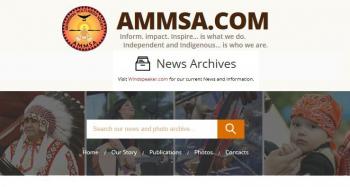Summary
Cheryl Bryce of the Lekwammen Nation welcomed delegates from the Champagne and Aishihik Nation to the traditional territory of the Songhees on Nov. 30, 2000. The reason for the visit to Metulia (Victoria) was to announce the progress of research being done on human remains that were found at the edge of a glacier in Northwestern British Columbia.
On Aug. 14, 1999, a party of three non-Aboriginal sheep hunters found artifacts and human remains in the Tatsenshini-Alsek Park in the northwest corner of B.C., near the Yukon. The hunters had traveled from the southeast corner of B.C. to get to the park, a distance of some 3,000 km.
William Hanlon, a teacher from Elkford and co-discoverer of the remains, addressed an audience of several hundred people at the University of Victoria during this, the first public release of findings.
“There was a number of sequences of coincidences that occurred” that led to the discovery, he said. They had won their limited entry hunting tickets through a lottery and weather and animal patterns led them to the high ground far above the tree line.
As soon as was possible, the hunters notified authorities at the Beringia Centre, a museum in the Yukon, about their discovery of the remains. Subsequently, the Yukon Heritage Branch, Champagne Aishihik First Nations and the RCMP were notified. A helicopter was dispatched carrying a site assessment archaeologist and representatives of the Champagne Aishihik First Nations.
The remains were found in the traditional territory of the Champagne Aishihik. In 1995, the Champagne Aishihuk First Nations signed a treaty in the Yukon that gave them self-governing powers that included authority over cultural and heritage resources within their territory.
The discovery of the human remains in the glacier was significant because the local First Nations were the ones who had immediate authority.
Ron Chambers, council member of the Champagne Aishihik Government, spoke of the importance of the discovery and what role their government played.
“This whole process has been a learning process for us.”
Lawrence Joe, resource management officer for Champagne Aishihik said protocol was addressed before anything was done at the discovery site.
“A prayer was said because of the respect that we have.”
Diane Strand, heritage resources officer and member of the Champagne and Aishihik First Nations, said Elders in the territory wanted to know where the remains were from. The decision was made to recover the body for research and the Elders named the body Kwaday Dan Sinchi. Translated the name means Long Ago Person Found.
"He was found for a reason. He was meant to be found," Strand said.
The territory of the Champagne Aishihik First Nation straddles borders of Yukon and British Columbia. A highway cuts through the land and marks the edge of the largest protected piece of land in the world. Mountains and borders have separated the Champagne Aishihik from their ancestral relatives, the Tlingit. Long Ago Person Found has helped in breaking down the barriers between the two First Nations.
“We've gone to our neighbors with this and they are extremely interested in it,” said Strand. “We're coming back full circle to the way we were before the borders put a stop to our interrelationship-trading between the two nations.”
Two weeks after the discovery, the Champagne and Aishihik First Nations, the B.C. Ministry of Small Business Tourism and Culture and other organizations, worked to reach agreement on the terms under which studies would proceed. The goal was to ensure cultural concerns were respected while recognizing the important scientific considerations inherent in a find of this nature.
On Aug. 31, 1999, a management agreement was reached with a deadline of Dec. 31, 2000.
A call for proposals went out to all Canadian universities, as well as selected institutions worldwide. Some 17 research projects were undertaken on the remains. The participating researchers had to fund their projects on their own accord, and key elements of the research agreements demanded consistency with the management agreement. All sample residues would be returned and no researcher would own samples or genetic or other materials.
Long Ago Person Found had some artifacts with him. Carbon dating has shown some discrepancies between some wooden artifacts found and a robe and hat. The tools are dated to about 200 or 300 years old while the ground squirrel (gopher) robe and a spruce root hat are about 550 years old. The discrepancy indicates that there was more than one event at this site.
The hat is similar to the coastal Tlingit style. Additionally, Long Ago Person Found was carrying food (dried fish) and tools.
He was approximately 20 years old and 5'5" tall. Long Ago Person Found was still growing, as he hadn't reached maturity. The medical research is still in progress, but at this time there is no indication of cause or manner of death or of any health problems. Not all of the body was recovered as some parts broke off with the melting of the glacier and exposure.
The wooden artifacts found with Long Ago Person Found are stored in Whitehorse under the care of the Yukon Heritage Branch. The Royal British Columbia Museum has been stabilizing the robe and hat, as well as holding the human remains in a frozen state. The Champagne and Aishihik Council will be meeting in the middle of December 2000 to discuss what they will do with the remains and artifacts. They are consulting with their neighboring communities as well.
Visit http://AMMSA.com for more stories from our publishing past.

